Analysis of Management Approaches for SARHS Organizational Change
VerifiedAdded on 2022/10/11
|19
|4536
|16
Report
AI Summary
This report analyzes the case of SAR Health Services (SARHS), a multinational company undergoing organizational change. The report examines the challenges the management team faces during this transition, including employee management issues, conflicts, and resistance to change. It explores the importance of effective communication, resource allocation, and stakeholder engagement. The report identifies key factors for successful change management, such as understanding change management terminology, considering the company's environment, size, technology, and life cycle. It also offers recommendations for mitigating risks, managing dependencies, and fostering employee support. The report highlights the need for a strategic approach to change, emphasizing the importance of planning, communication, and recognizing successes to ensure a smooth and positive outcome for SARHS's organizational transformation. The report concludes with a discussion of the models and processes of change management and provides recommendations for change management.
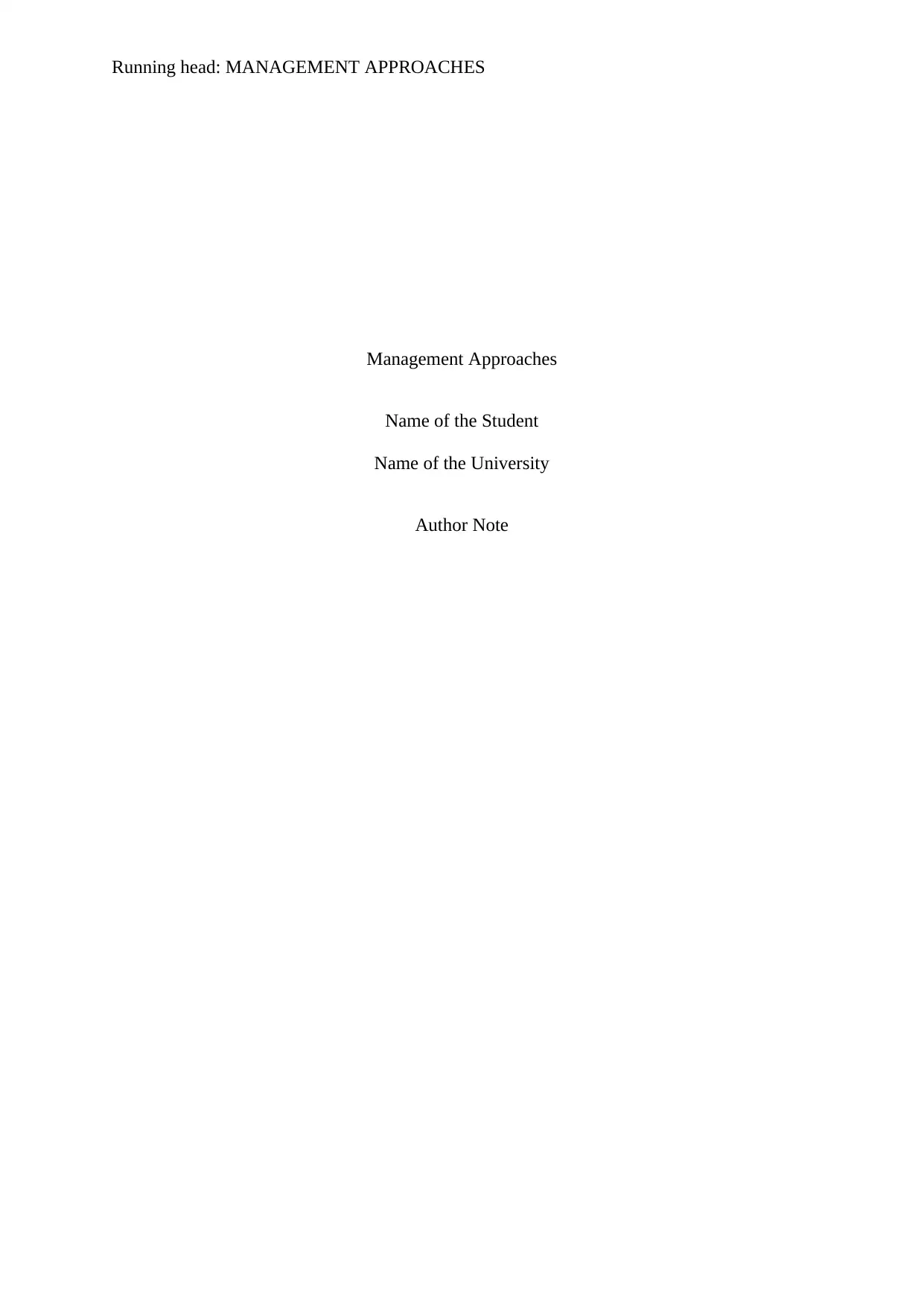
Running head: MANAGEMENT APPROACHES
Management Approaches
Name of the Student
Name of the University
Author Note
Management Approaches
Name of the Student
Name of the University
Author Note
Paraphrase This Document
Need a fresh take? Get an instant paraphrase of this document with our AI Paraphraser
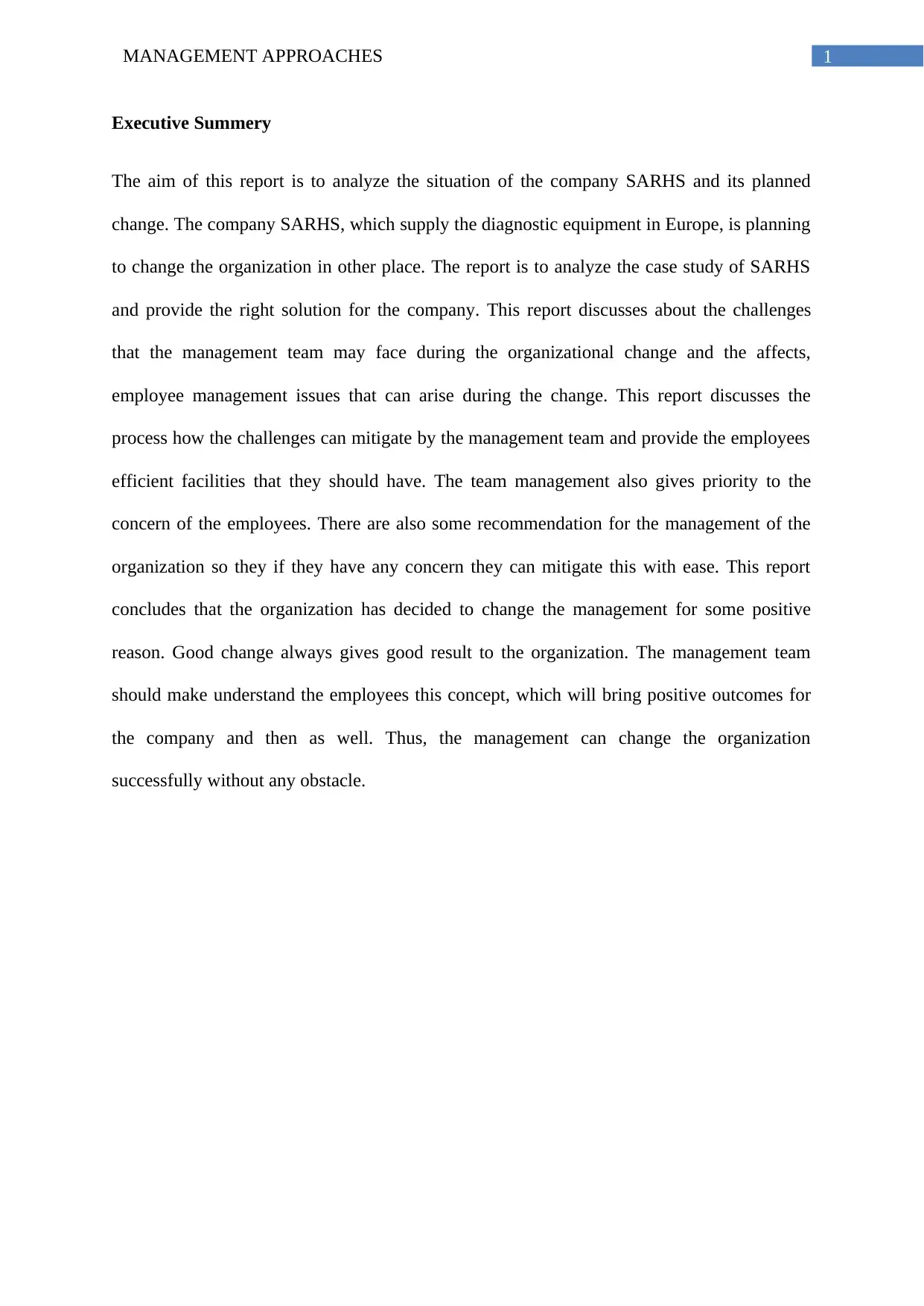
1MANAGEMENT APPROACHES
Executive Summery
The aim of this report is to analyze the situation of the company SARHS and its planned
change. The company SARHS, which supply the diagnostic equipment in Europe, is planning
to change the organization in other place. The report is to analyze the case study of SARHS
and provide the right solution for the company. This report discusses about the challenges
that the management team may face during the organizational change and the affects,
employee management issues that can arise during the change. This report discusses the
process how the challenges can mitigate by the management team and provide the employees
efficient facilities that they should have. The team management also gives priority to the
concern of the employees. There are also some recommendation for the management of the
organization so they if they have any concern they can mitigate this with ease. This report
concludes that the organization has decided to change the management for some positive
reason. Good change always gives good result to the organization. The management team
should make understand the employees this concept, which will bring positive outcomes for
the company and then as well. Thus, the management can change the organization
successfully without any obstacle.
Executive Summery
The aim of this report is to analyze the situation of the company SARHS and its planned
change. The company SARHS, which supply the diagnostic equipment in Europe, is planning
to change the organization in other place. The report is to analyze the case study of SARHS
and provide the right solution for the company. This report discusses about the challenges
that the management team may face during the organizational change and the affects,
employee management issues that can arise during the change. This report discusses the
process how the challenges can mitigate by the management team and provide the employees
efficient facilities that they should have. The team management also gives priority to the
concern of the employees. There are also some recommendation for the management of the
organization so they if they have any concern they can mitigate this with ease. This report
concludes that the organization has decided to change the management for some positive
reason. Good change always gives good result to the organization. The management team
should make understand the employees this concept, which will bring positive outcomes for
the company and then as well. Thus, the management can change the organization
successfully without any obstacle.
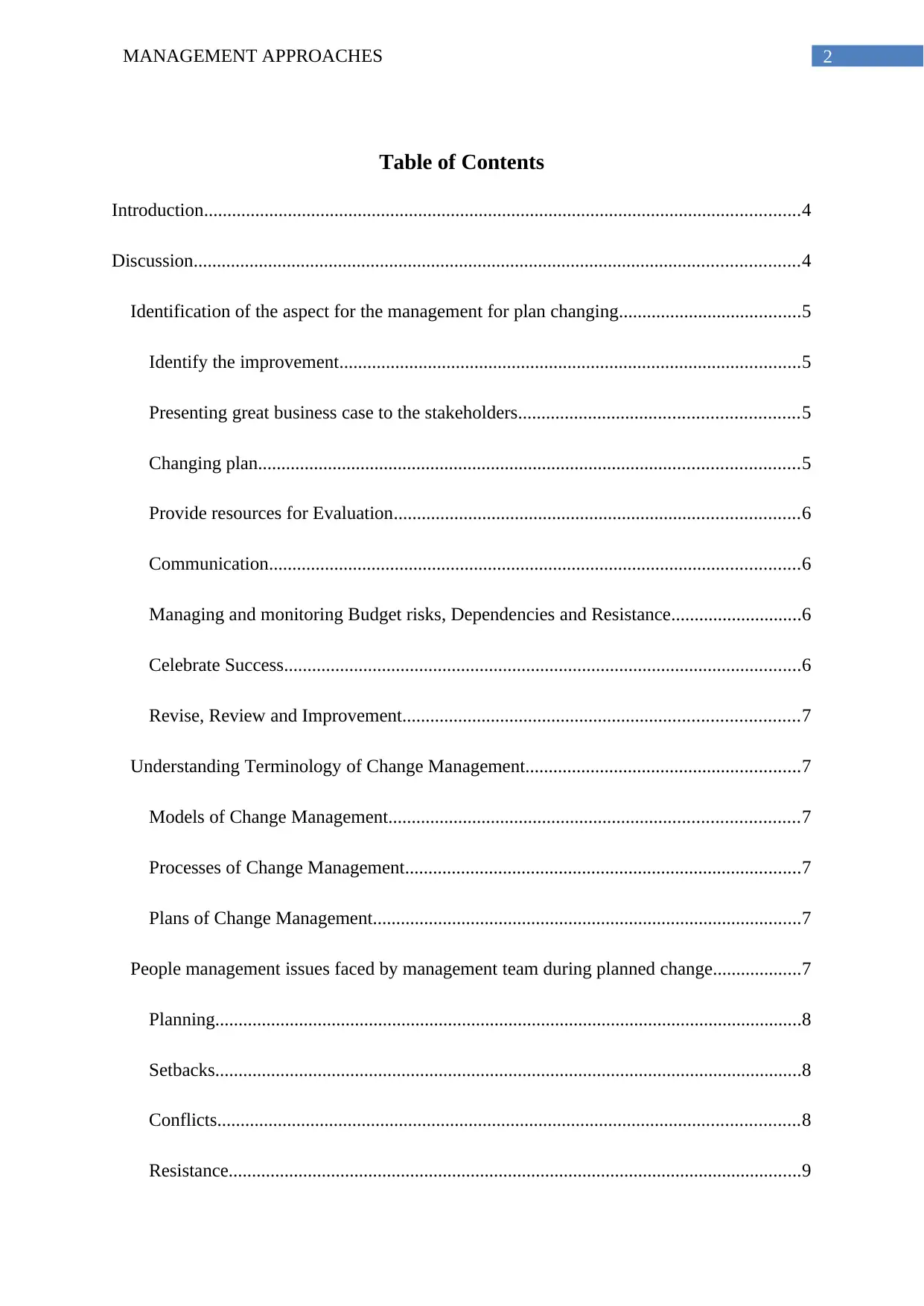
2MANAGEMENT APPROACHES
Table of Contents
Introduction................................................................................................................................4
Discussion..................................................................................................................................4
Identification of the aspect for the management for plan changing.......................................5
Identify the improvement...................................................................................................5
Presenting great business case to the stakeholders............................................................5
Changing plan....................................................................................................................5
Provide resources for Evaluation.......................................................................................6
Communication..................................................................................................................6
Managing and monitoring Budget risks, Dependencies and Resistance............................6
Celebrate Success...............................................................................................................6
Revise, Review and Improvement.....................................................................................7
Understanding Terminology of Change Management...........................................................7
Models of Change Management........................................................................................7
Processes of Change Management.....................................................................................7
Plans of Change Management............................................................................................7
People management issues faced by management team during planned change...................7
Planning..............................................................................................................................8
Setbacks..............................................................................................................................8
Conflicts.............................................................................................................................8
Resistance...........................................................................................................................9
Table of Contents
Introduction................................................................................................................................4
Discussion..................................................................................................................................4
Identification of the aspect for the management for plan changing.......................................5
Identify the improvement...................................................................................................5
Presenting great business case to the stakeholders............................................................5
Changing plan....................................................................................................................5
Provide resources for Evaluation.......................................................................................6
Communication..................................................................................................................6
Managing and monitoring Budget risks, Dependencies and Resistance............................6
Celebrate Success...............................................................................................................6
Revise, Review and Improvement.....................................................................................7
Understanding Terminology of Change Management...........................................................7
Models of Change Management........................................................................................7
Processes of Change Management.....................................................................................7
Plans of Change Management............................................................................................7
People management issues faced by management team during planned change...................7
Planning..............................................................................................................................8
Setbacks..............................................................................................................................8
Conflicts.............................................................................................................................8
Resistance...........................................................................................................................9
⊘ This is a preview!⊘
Do you want full access?
Subscribe today to unlock all pages.

Trusted by 1+ million students worldwide
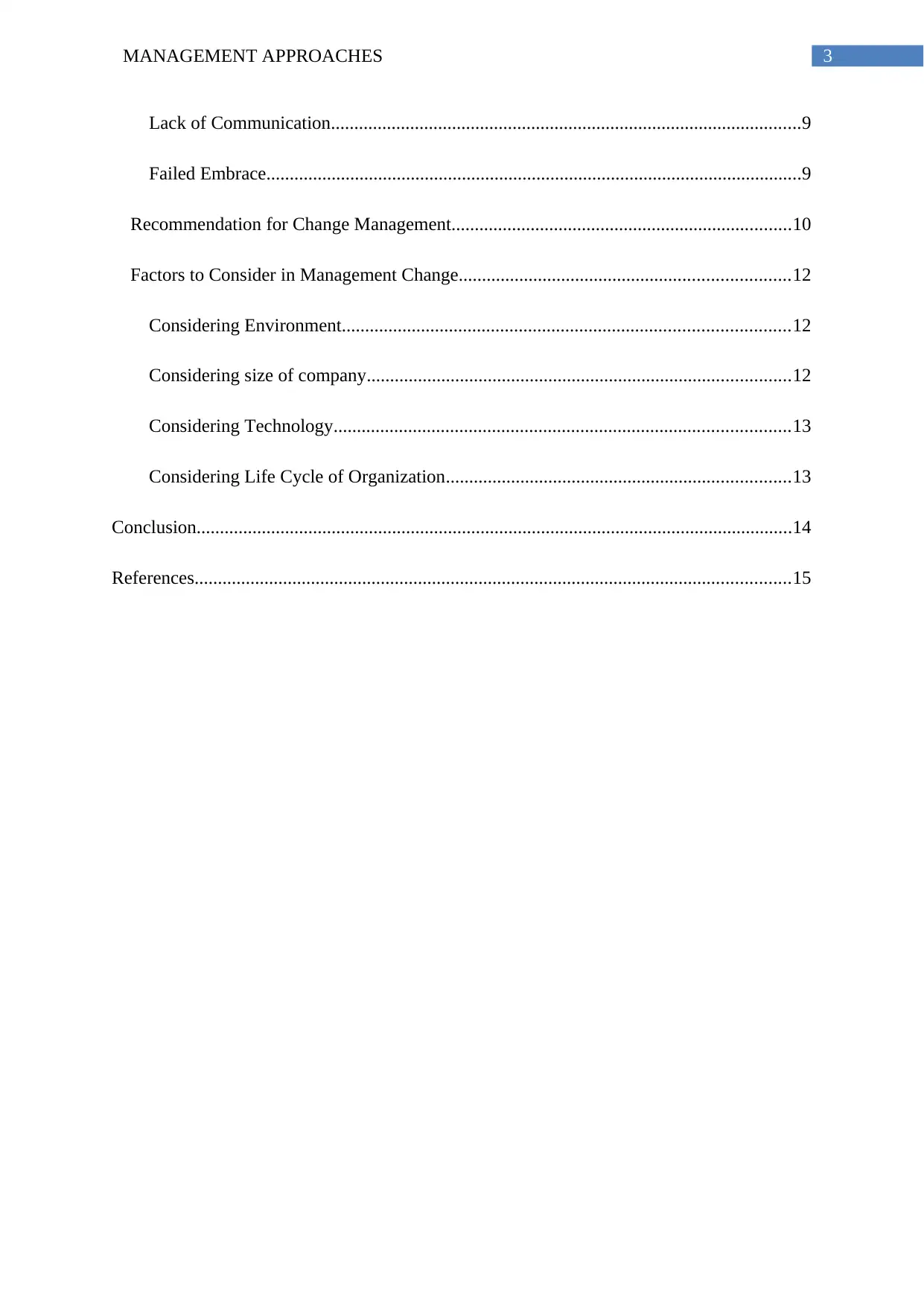
3MANAGEMENT APPROACHES
Lack of Communication.....................................................................................................9
Failed Embrace...................................................................................................................9
Recommendation for Change Management.........................................................................10
Factors to Consider in Management Change.......................................................................12
Considering Environment................................................................................................12
Considering size of company...........................................................................................12
Considering Technology..................................................................................................13
Considering Life Cycle of Organization..........................................................................13
Conclusion................................................................................................................................14
References................................................................................................................................15
Lack of Communication.....................................................................................................9
Failed Embrace...................................................................................................................9
Recommendation for Change Management.........................................................................10
Factors to Consider in Management Change.......................................................................12
Considering Environment................................................................................................12
Considering size of company...........................................................................................12
Considering Technology..................................................................................................13
Considering Life Cycle of Organization..........................................................................13
Conclusion................................................................................................................................14
References................................................................................................................................15
Paraphrase This Document
Need a fresh take? Get an instant paraphrase of this document with our AI Paraphraser
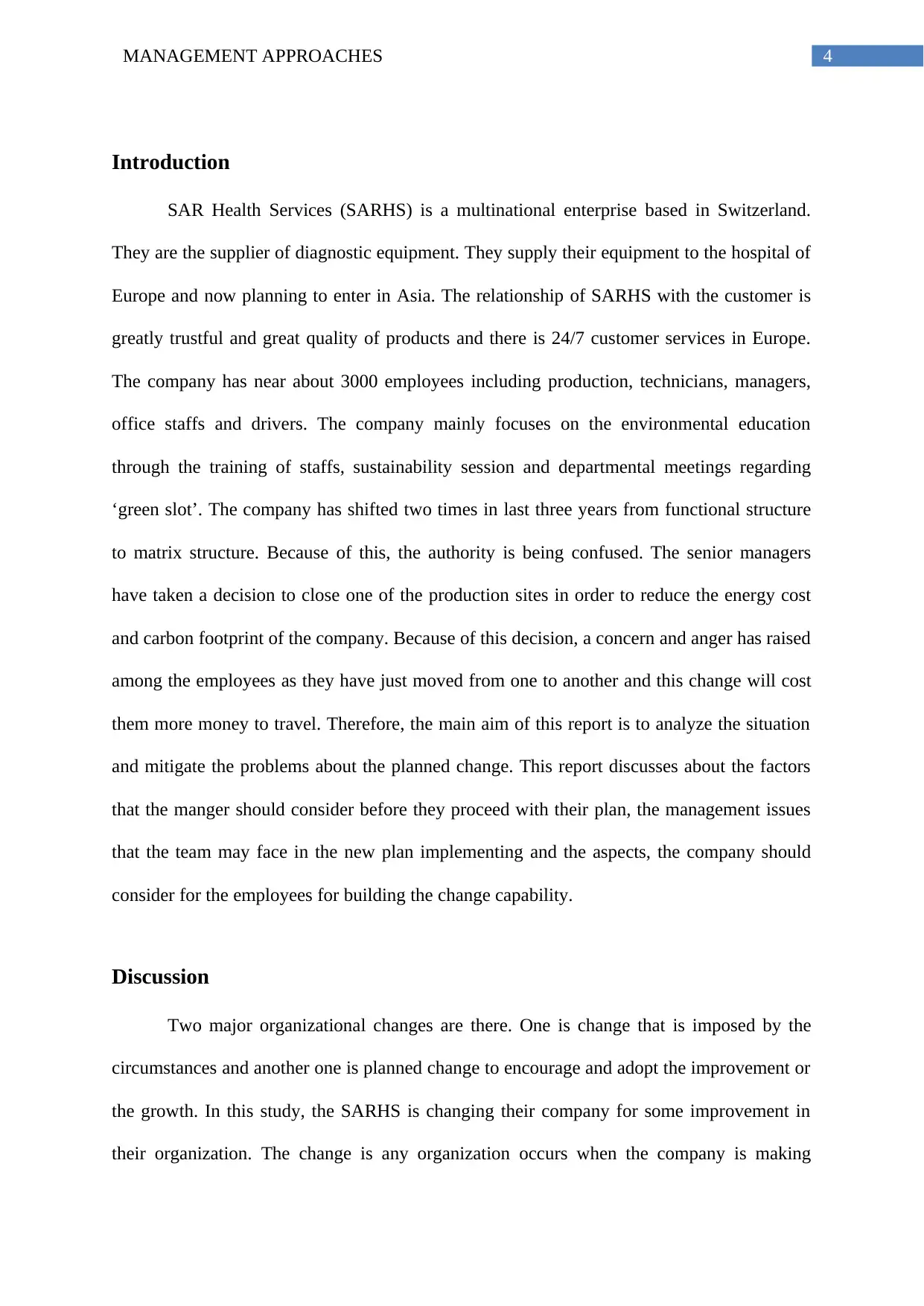
4MANAGEMENT APPROACHES
Introduction
SAR Health Services (SARHS) is a multinational enterprise based in Switzerland.
They are the supplier of diagnostic equipment. They supply their equipment to the hospital of
Europe and now planning to enter in Asia. The relationship of SARHS with the customer is
greatly trustful and great quality of products and there is 24/7 customer services in Europe.
The company has near about 3000 employees including production, technicians, managers,
office staffs and drivers. The company mainly focuses on the environmental education
through the training of staffs, sustainability session and departmental meetings regarding
‘green slot’. The company has shifted two times in last three years from functional structure
to matrix structure. Because of this, the authority is being confused. The senior managers
have taken a decision to close one of the production sites in order to reduce the energy cost
and carbon footprint of the company. Because of this decision, a concern and anger has raised
among the employees as they have just moved from one to another and this change will cost
them more money to travel. Therefore, the main aim of this report is to analyze the situation
and mitigate the problems about the planned change. This report discusses about the factors
that the manger should consider before they proceed with their plan, the management issues
that the team may face in the new plan implementing and the aspects, the company should
consider for the employees for building the change capability.
Discussion
Two major organizational changes are there. One is change that is imposed by the
circumstances and another one is planned change to encourage and adopt the improvement or
the growth. In this study, the SARHS is changing their company for some improvement in
their organization. The change is any organization occurs when the company is making
Introduction
SAR Health Services (SARHS) is a multinational enterprise based in Switzerland.
They are the supplier of diagnostic equipment. They supply their equipment to the hospital of
Europe and now planning to enter in Asia. The relationship of SARHS with the customer is
greatly trustful and great quality of products and there is 24/7 customer services in Europe.
The company has near about 3000 employees including production, technicians, managers,
office staffs and drivers. The company mainly focuses on the environmental education
through the training of staffs, sustainability session and departmental meetings regarding
‘green slot’. The company has shifted two times in last three years from functional structure
to matrix structure. Because of this, the authority is being confused. The senior managers
have taken a decision to close one of the production sites in order to reduce the energy cost
and carbon footprint of the company. Because of this decision, a concern and anger has raised
among the employees as they have just moved from one to another and this change will cost
them more money to travel. Therefore, the main aim of this report is to analyze the situation
and mitigate the problems about the planned change. This report discusses about the factors
that the manger should consider before they proceed with their plan, the management issues
that the team may face in the new plan implementing and the aspects, the company should
consider for the employees for building the change capability.
Discussion
Two major organizational changes are there. One is change that is imposed by the
circumstances and another one is planned change to encourage and adopt the improvement or
the growth. In this study, the SARHS is changing their company for some improvement in
their organization. The change is any organization occurs when the company is making
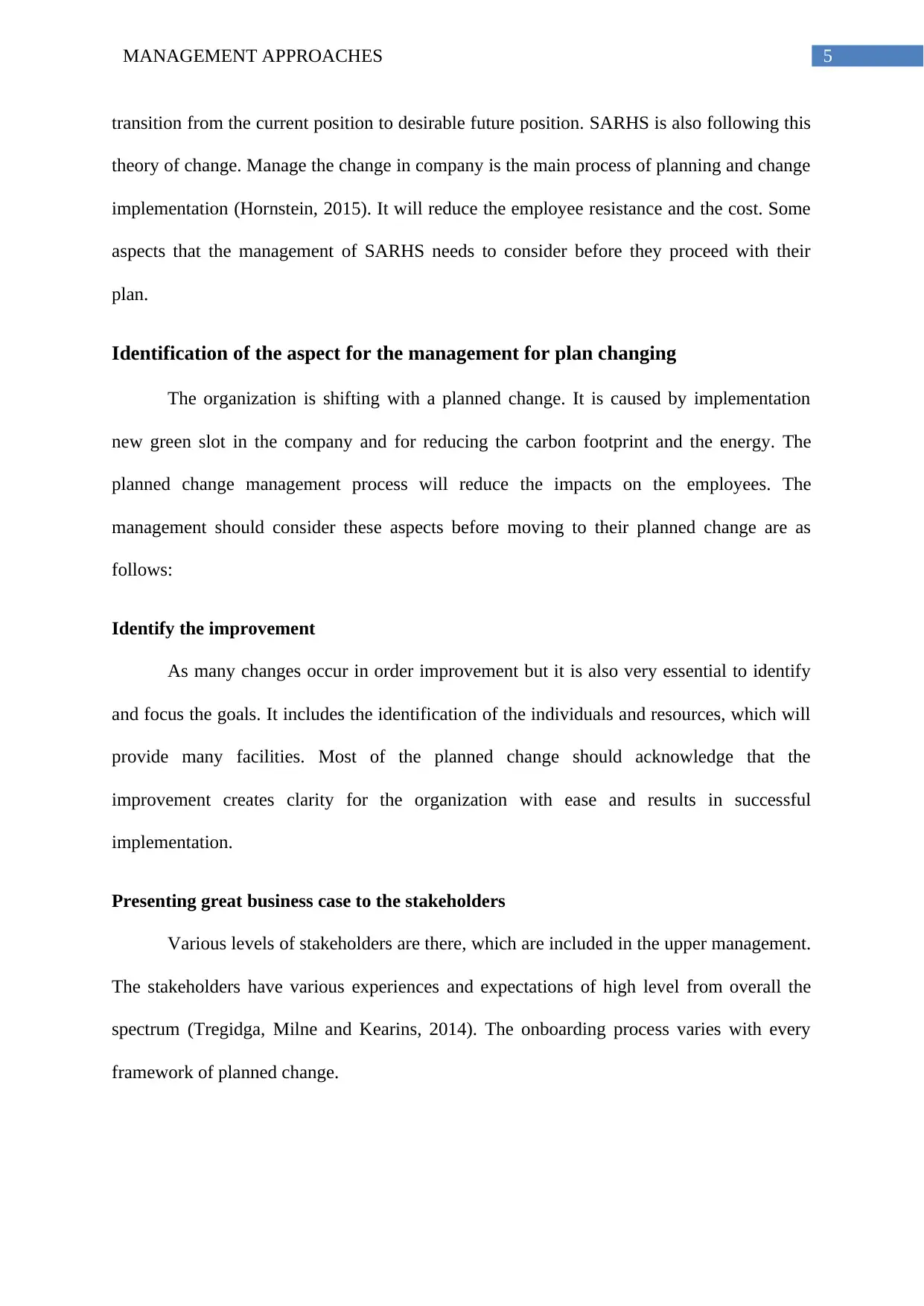
5MANAGEMENT APPROACHES
transition from the current position to desirable future position. SARHS is also following this
theory of change. Manage the change in company is the main process of planning and change
implementation (Hornstein, 2015). It will reduce the employee resistance and the cost. Some
aspects that the management of SARHS needs to consider before they proceed with their
plan.
Identification of the aspect for the management for plan changing
The organization is shifting with a planned change. It is caused by implementation
new green slot in the company and for reducing the carbon footprint and the energy. The
planned change management process will reduce the impacts on the employees. The
management should consider these aspects before moving to their planned change are as
follows:
Identify the improvement
As many changes occur in order improvement but it is also very essential to identify
and focus the goals. It includes the identification of the individuals and resources, which will
provide many facilities. Most of the planned change should acknowledge that the
improvement creates clarity for the organization with ease and results in successful
implementation.
Presenting great business case to the stakeholders
Various levels of stakeholders are there, which are included in the upper management.
The stakeholders have various experiences and expectations of high level from overall the
spectrum (Tregidga, Milne and Kearins, 2014). The onboarding process varies with every
framework of planned change.
transition from the current position to desirable future position. SARHS is also following this
theory of change. Manage the change in company is the main process of planning and change
implementation (Hornstein, 2015). It will reduce the employee resistance and the cost. Some
aspects that the management of SARHS needs to consider before they proceed with their
plan.
Identification of the aspect for the management for plan changing
The organization is shifting with a planned change. It is caused by implementation
new green slot in the company and for reducing the carbon footprint and the energy. The
planned change management process will reduce the impacts on the employees. The
management should consider these aspects before moving to their planned change are as
follows:
Identify the improvement
As many changes occur in order improvement but it is also very essential to identify
and focus the goals. It includes the identification of the individuals and resources, which will
provide many facilities. Most of the planned change should acknowledge that the
improvement creates clarity for the organization with ease and results in successful
implementation.
Presenting great business case to the stakeholders
Various levels of stakeholders are there, which are included in the upper management.
The stakeholders have various experiences and expectations of high level from overall the
spectrum (Tregidga, Milne and Kearins, 2014). The onboarding process varies with every
framework of planned change.
⊘ This is a preview!⊘
Do you want full access?
Subscribe today to unlock all pages.

Trusted by 1+ million students worldwide
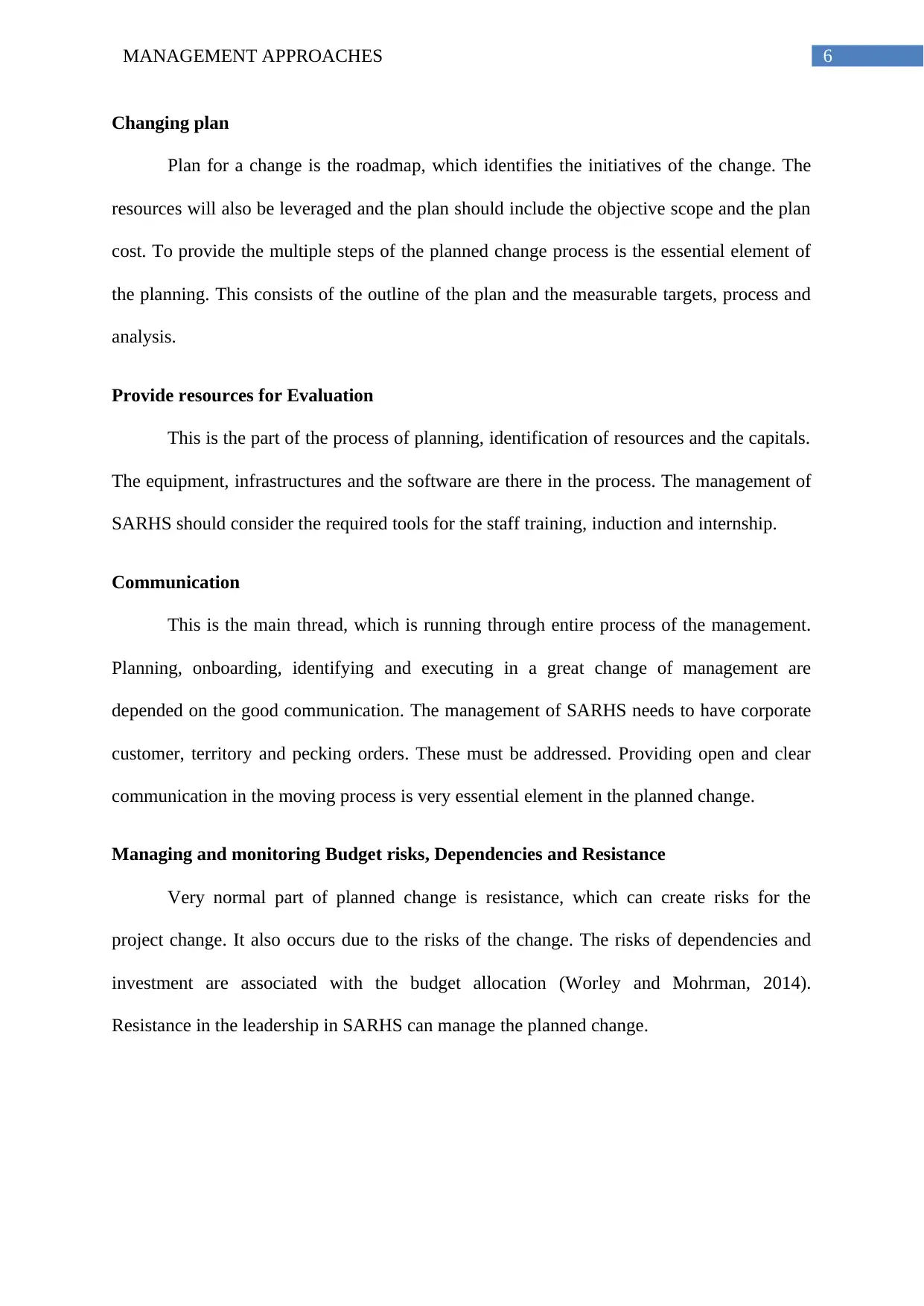
6MANAGEMENT APPROACHES
Changing plan
Plan for a change is the roadmap, which identifies the initiatives of the change. The
resources will also be leveraged and the plan should include the objective scope and the plan
cost. To provide the multiple steps of the planned change process is the essential element of
the planning. This consists of the outline of the plan and the measurable targets, process and
analysis.
Provide resources for Evaluation
This is the part of the process of planning, identification of resources and the capitals.
The equipment, infrastructures and the software are there in the process. The management of
SARHS should consider the required tools for the staff training, induction and internship.
Communication
This is the main thread, which is running through entire process of the management.
Planning, onboarding, identifying and executing in a great change of management are
depended on the good communication. The management of SARHS needs to have corporate
customer, territory and pecking orders. These must be addressed. Providing open and clear
communication in the moving process is very essential element in the planned change.
Managing and monitoring Budget risks, Dependencies and Resistance
Very normal part of planned change is resistance, which can create risks for the
project change. It also occurs due to the risks of the change. The risks of dependencies and
investment are associated with the budget allocation (Worley and Mohrman, 2014).
Resistance in the leadership in SARHS can manage the planned change.
Changing plan
Plan for a change is the roadmap, which identifies the initiatives of the change. The
resources will also be leveraged and the plan should include the objective scope and the plan
cost. To provide the multiple steps of the planned change process is the essential element of
the planning. This consists of the outline of the plan and the measurable targets, process and
analysis.
Provide resources for Evaluation
This is the part of the process of planning, identification of resources and the capitals.
The equipment, infrastructures and the software are there in the process. The management of
SARHS should consider the required tools for the staff training, induction and internship.
Communication
This is the main thread, which is running through entire process of the management.
Planning, onboarding, identifying and executing in a great change of management are
depended on the good communication. The management of SARHS needs to have corporate
customer, territory and pecking orders. These must be addressed. Providing open and clear
communication in the moving process is very essential element in the planned change.
Managing and monitoring Budget risks, Dependencies and Resistance
Very normal part of planned change is resistance, which can create risks for the
project change. It also occurs due to the risks of the change. The risks of dependencies and
investment are associated with the budget allocation (Worley and Mohrman, 2014).
Resistance in the leadership in SARHS can manage the planned change.
Paraphrase This Document
Need a fresh take? Get an instant paraphrase of this document with our AI Paraphraser
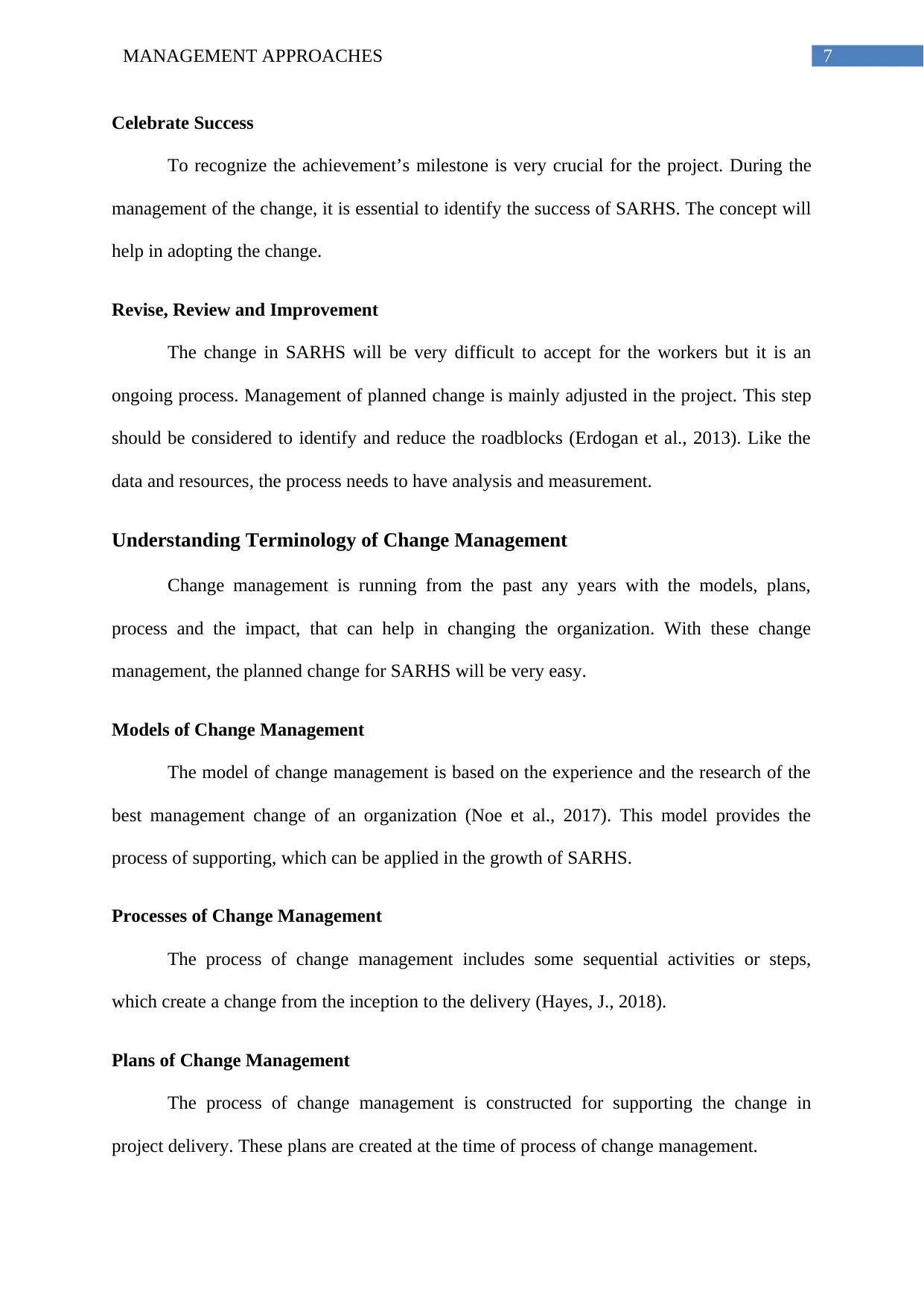
7MANAGEMENT APPROACHES
Celebrate Success
To recognize the achievement’s milestone is very crucial for the project. During the
management of the change, it is essential to identify the success of SARHS. The concept will
help in adopting the change.
Revise, Review and Improvement
The change in SARHS will be very difficult to accept for the workers but it is an
ongoing process. Management of planned change is mainly adjusted in the project. This step
should be considered to identify and reduce the roadblocks (Erdogan et al., 2013). Like the
data and resources, the process needs to have analysis and measurement.
Understanding Terminology of Change Management
Change management is running from the past any years with the models, plans,
process and the impact, that can help in changing the organization. With these change
management, the planned change for SARHS will be very easy.
Models of Change Management
The model of change management is based on the experience and the research of the
best management change of an organization (Noe et al., 2017). This model provides the
process of supporting, which can be applied in the growth of SARHS.
Processes of Change Management
The process of change management includes some sequential activities or steps,
which create a change from the inception to the delivery (Hayes, J., 2018).
Plans of Change Management
The process of change management is constructed for supporting the change in
project delivery. These plans are created at the time of process of change management.
Celebrate Success
To recognize the achievement’s milestone is very crucial for the project. During the
management of the change, it is essential to identify the success of SARHS. The concept will
help in adopting the change.
Revise, Review and Improvement
The change in SARHS will be very difficult to accept for the workers but it is an
ongoing process. Management of planned change is mainly adjusted in the project. This step
should be considered to identify and reduce the roadblocks (Erdogan et al., 2013). Like the
data and resources, the process needs to have analysis and measurement.
Understanding Terminology of Change Management
Change management is running from the past any years with the models, plans,
process and the impact, that can help in changing the organization. With these change
management, the planned change for SARHS will be very easy.
Models of Change Management
The model of change management is based on the experience and the research of the
best management change of an organization (Noe et al., 2017). This model provides the
process of supporting, which can be applied in the growth of SARHS.
Processes of Change Management
The process of change management includes some sequential activities or steps,
which create a change from the inception to the delivery (Hayes, J., 2018).
Plans of Change Management
The process of change management is constructed for supporting the change in
project delivery. These plans are created at the time of process of change management.
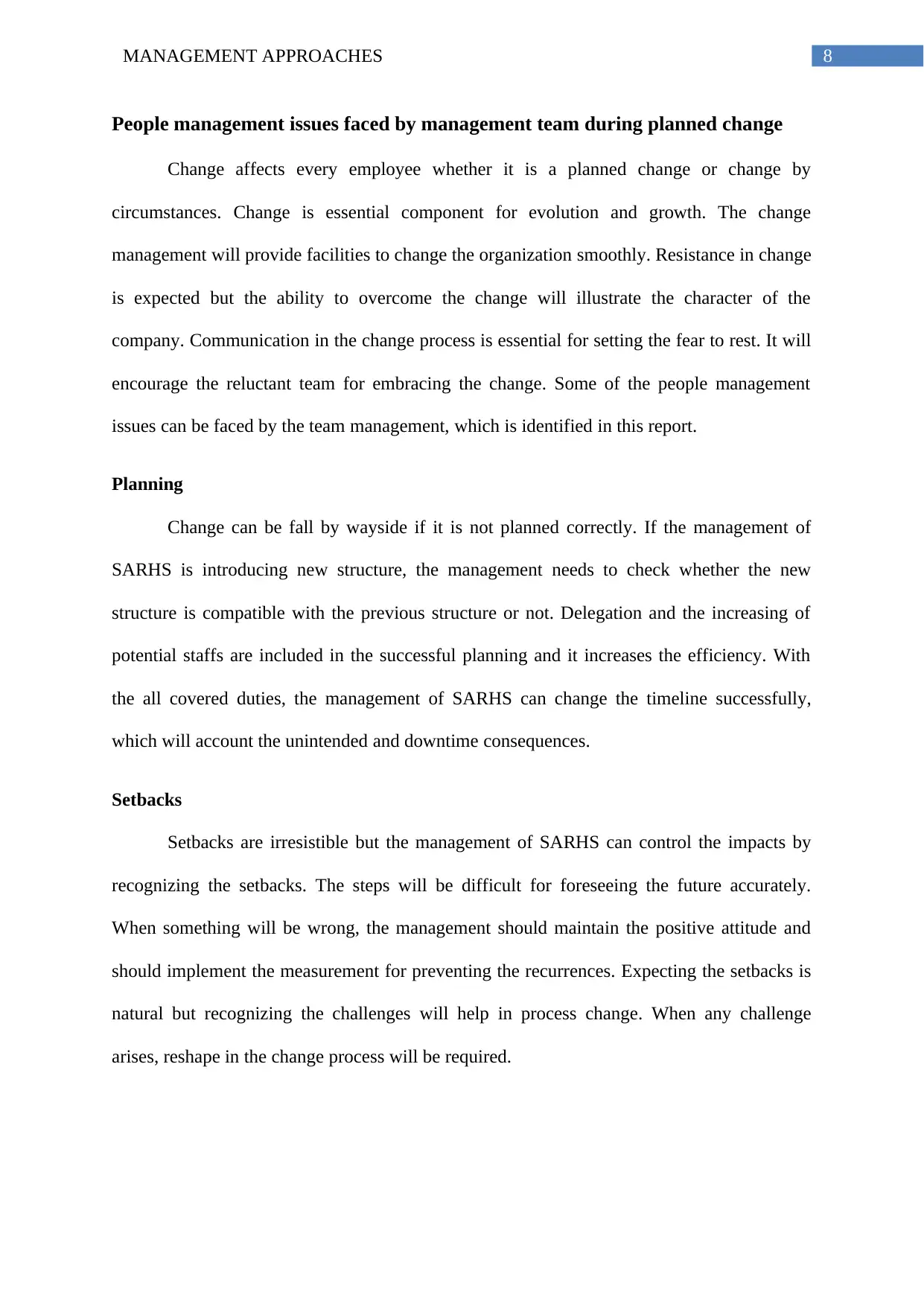
8MANAGEMENT APPROACHES
People management issues faced by management team during planned change
Change affects every employee whether it is a planned change or change by
circumstances. Change is essential component for evolution and growth. The change
management will provide facilities to change the organization smoothly. Resistance in change
is expected but the ability to overcome the change will illustrate the character of the
company. Communication in the change process is essential for setting the fear to rest. It will
encourage the reluctant team for embracing the change. Some of the people management
issues can be faced by the team management, which is identified in this report.
Planning
Change can be fall by wayside if it is not planned correctly. If the management of
SARHS is introducing new structure, the management needs to check whether the new
structure is compatible with the previous structure or not. Delegation and the increasing of
potential staffs are included in the successful planning and it increases the efficiency. With
the all covered duties, the management of SARHS can change the timeline successfully,
which will account the unintended and downtime consequences.
Setbacks
Setbacks are irresistible but the management of SARHS can control the impacts by
recognizing the setbacks. The steps will be difficult for foreseeing the future accurately.
When something will be wrong, the management should maintain the positive attitude and
should implement the measurement for preventing the recurrences. Expecting the setbacks is
natural but recognizing the challenges will help in process change. When any challenge
arises, reshape in the change process will be required.
People management issues faced by management team during planned change
Change affects every employee whether it is a planned change or change by
circumstances. Change is essential component for evolution and growth. The change
management will provide facilities to change the organization smoothly. Resistance in change
is expected but the ability to overcome the change will illustrate the character of the
company. Communication in the change process is essential for setting the fear to rest. It will
encourage the reluctant team for embracing the change. Some of the people management
issues can be faced by the team management, which is identified in this report.
Planning
Change can be fall by wayside if it is not planned correctly. If the management of
SARHS is introducing new structure, the management needs to check whether the new
structure is compatible with the previous structure or not. Delegation and the increasing of
potential staffs are included in the successful planning and it increases the efficiency. With
the all covered duties, the management of SARHS can change the timeline successfully,
which will account the unintended and downtime consequences.
Setbacks
Setbacks are irresistible but the management of SARHS can control the impacts by
recognizing the setbacks. The steps will be difficult for foreseeing the future accurately.
When something will be wrong, the management should maintain the positive attitude and
should implement the measurement for preventing the recurrences. Expecting the setbacks is
natural but recognizing the challenges will help in process change. When any challenge
arises, reshape in the change process will be required.
⊘ This is a preview!⊘
Do you want full access?
Subscribe today to unlock all pages.

Trusted by 1+ million students worldwide
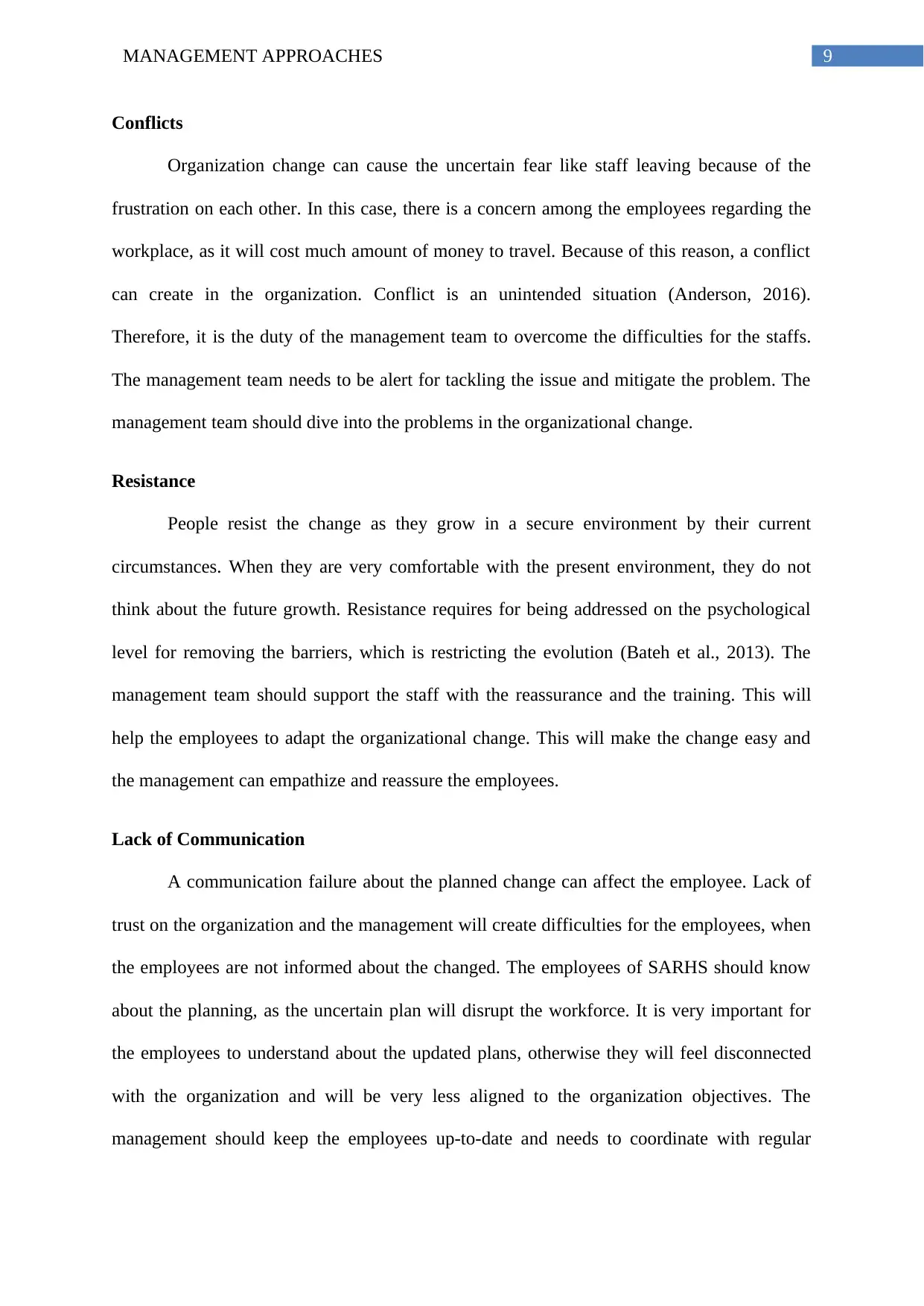
9MANAGEMENT APPROACHES
Conflicts
Organization change can cause the uncertain fear like staff leaving because of the
frustration on each other. In this case, there is a concern among the employees regarding the
workplace, as it will cost much amount of money to travel. Because of this reason, a conflict
can create in the organization. Conflict is an unintended situation (Anderson, 2016).
Therefore, it is the duty of the management team to overcome the difficulties for the staffs.
The management team needs to be alert for tackling the issue and mitigate the problem. The
management team should dive into the problems in the organizational change.
Resistance
People resist the change as they grow in a secure environment by their current
circumstances. When they are very comfortable with the present environment, they do not
think about the future growth. Resistance requires for being addressed on the psychological
level for removing the barriers, which is restricting the evolution (Bateh et al., 2013). The
management team should support the staff with the reassurance and the training. This will
help the employees to adapt the organizational change. This will make the change easy and
the management can empathize and reassure the employees.
Lack of Communication
A communication failure about the planned change can affect the employee. Lack of
trust on the organization and the management will create difficulties for the employees, when
the employees are not informed about the changed. The employees of SARHS should know
about the planning, as the uncertain plan will disrupt the workforce. It is very important for
the employees to understand about the updated plans, otherwise they will feel disconnected
with the organization and will be very less aligned to the organization objectives. The
management should keep the employees up-to-date and needs to coordinate with regular
Conflicts
Organization change can cause the uncertain fear like staff leaving because of the
frustration on each other. In this case, there is a concern among the employees regarding the
workplace, as it will cost much amount of money to travel. Because of this reason, a conflict
can create in the organization. Conflict is an unintended situation (Anderson, 2016).
Therefore, it is the duty of the management team to overcome the difficulties for the staffs.
The management team needs to be alert for tackling the issue and mitigate the problem. The
management team should dive into the problems in the organizational change.
Resistance
People resist the change as they grow in a secure environment by their current
circumstances. When they are very comfortable with the present environment, they do not
think about the future growth. Resistance requires for being addressed on the psychological
level for removing the barriers, which is restricting the evolution (Bateh et al., 2013). The
management team should support the staff with the reassurance and the training. This will
help the employees to adapt the organizational change. This will make the change easy and
the management can empathize and reassure the employees.
Lack of Communication
A communication failure about the planned change can affect the employee. Lack of
trust on the organization and the management will create difficulties for the employees, when
the employees are not informed about the changed. The employees of SARHS should know
about the planning, as the uncertain plan will disrupt the workforce. It is very important for
the employees to understand about the updated plans, otherwise they will feel disconnected
with the organization and will be very less aligned to the organization objectives. The
management should keep the employees up-to-date and needs to coordinate with regular
Paraphrase This Document
Need a fresh take? Get an instant paraphrase of this document with our AI Paraphraser
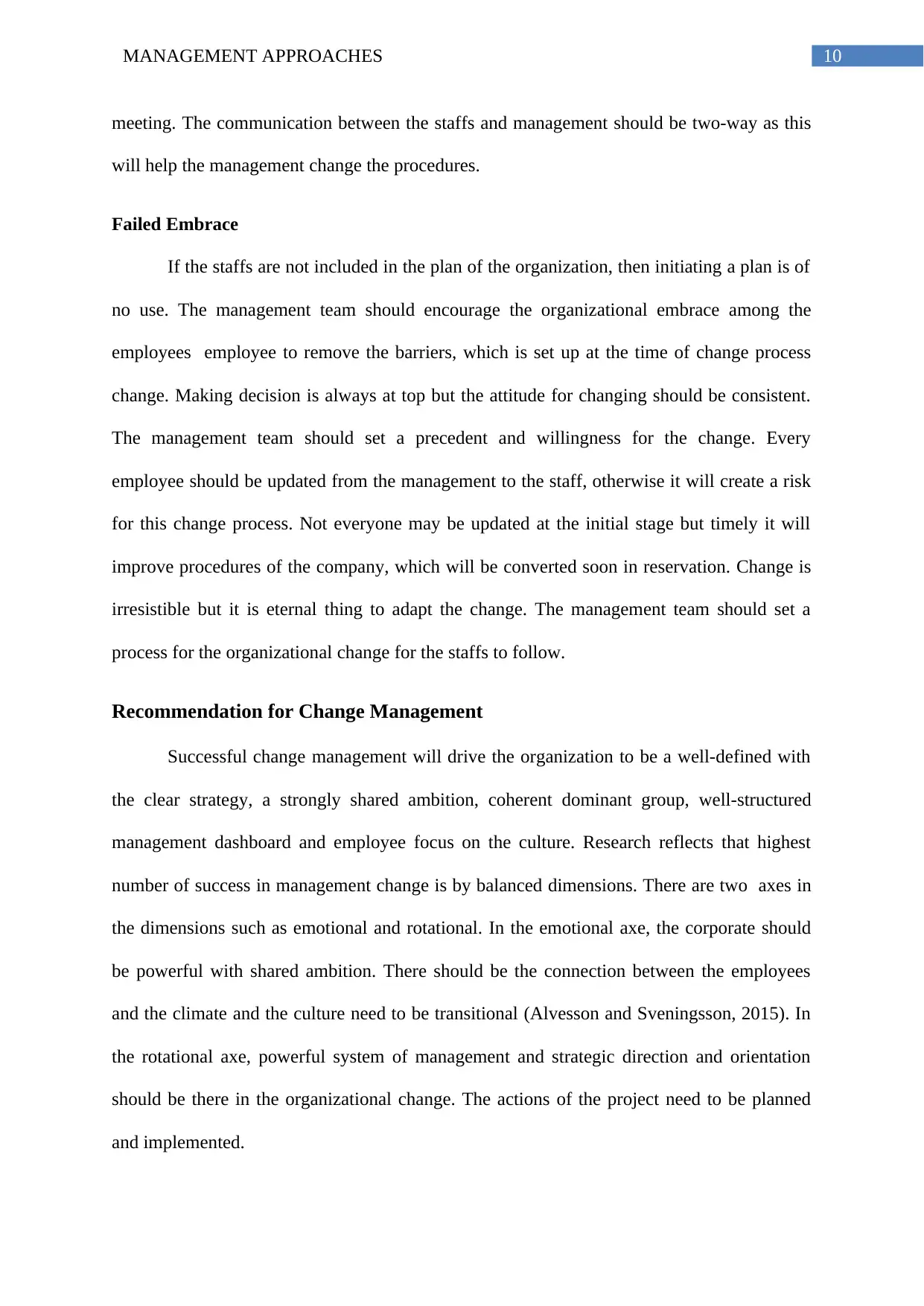
10MANAGEMENT APPROACHES
meeting. The communication between the staffs and management should be two-way as this
will help the management change the procedures.
Failed Embrace
If the staffs are not included in the plan of the organization, then initiating a plan is of
no use. The management team should encourage the organizational embrace among the
employees employee to remove the barriers, which is set up at the time of change process
change. Making decision is always at top but the attitude for changing should be consistent.
The management team should set a precedent and willingness for the change. Every
employee should be updated from the management to the staff, otherwise it will create a risk
for this change process. Not everyone may be updated at the initial stage but timely it will
improve procedures of the company, which will be converted soon in reservation. Change is
irresistible but it is eternal thing to adapt the change. The management team should set a
process for the organizational change for the staffs to follow.
Recommendation for Change Management
Successful change management will drive the organization to be a well-defined with
the clear strategy, a strongly shared ambition, coherent dominant group, well-structured
management dashboard and employee focus on the culture. Research reflects that highest
number of success in management change is by balanced dimensions. There are two axes in
the dimensions such as emotional and rotational. In the emotional axe, the corporate should
be powerful with shared ambition. There should be the connection between the employees
and the climate and the culture need to be transitional (Alvesson and Sveningsson, 2015). In
the rotational axe, powerful system of management and strategic direction and orientation
should be there in the organizational change. The actions of the project need to be planned
and implemented.
meeting. The communication between the staffs and management should be two-way as this
will help the management change the procedures.
Failed Embrace
If the staffs are not included in the plan of the organization, then initiating a plan is of
no use. The management team should encourage the organizational embrace among the
employees employee to remove the barriers, which is set up at the time of change process
change. Making decision is always at top but the attitude for changing should be consistent.
The management team should set a precedent and willingness for the change. Every
employee should be updated from the management to the staff, otherwise it will create a risk
for this change process. Not everyone may be updated at the initial stage but timely it will
improve procedures of the company, which will be converted soon in reservation. Change is
irresistible but it is eternal thing to adapt the change. The management team should set a
process for the organizational change for the staffs to follow.
Recommendation for Change Management
Successful change management will drive the organization to be a well-defined with
the clear strategy, a strongly shared ambition, coherent dominant group, well-structured
management dashboard and employee focus on the culture. Research reflects that highest
number of success in management change is by balanced dimensions. There are two axes in
the dimensions such as emotional and rotational. In the emotional axe, the corporate should
be powerful with shared ambition. There should be the connection between the employees
and the climate and the culture need to be transitional (Alvesson and Sveningsson, 2015). In
the rotational axe, powerful system of management and strategic direction and orientation
should be there in the organizational change. The actions of the project need to be planned
and implemented.
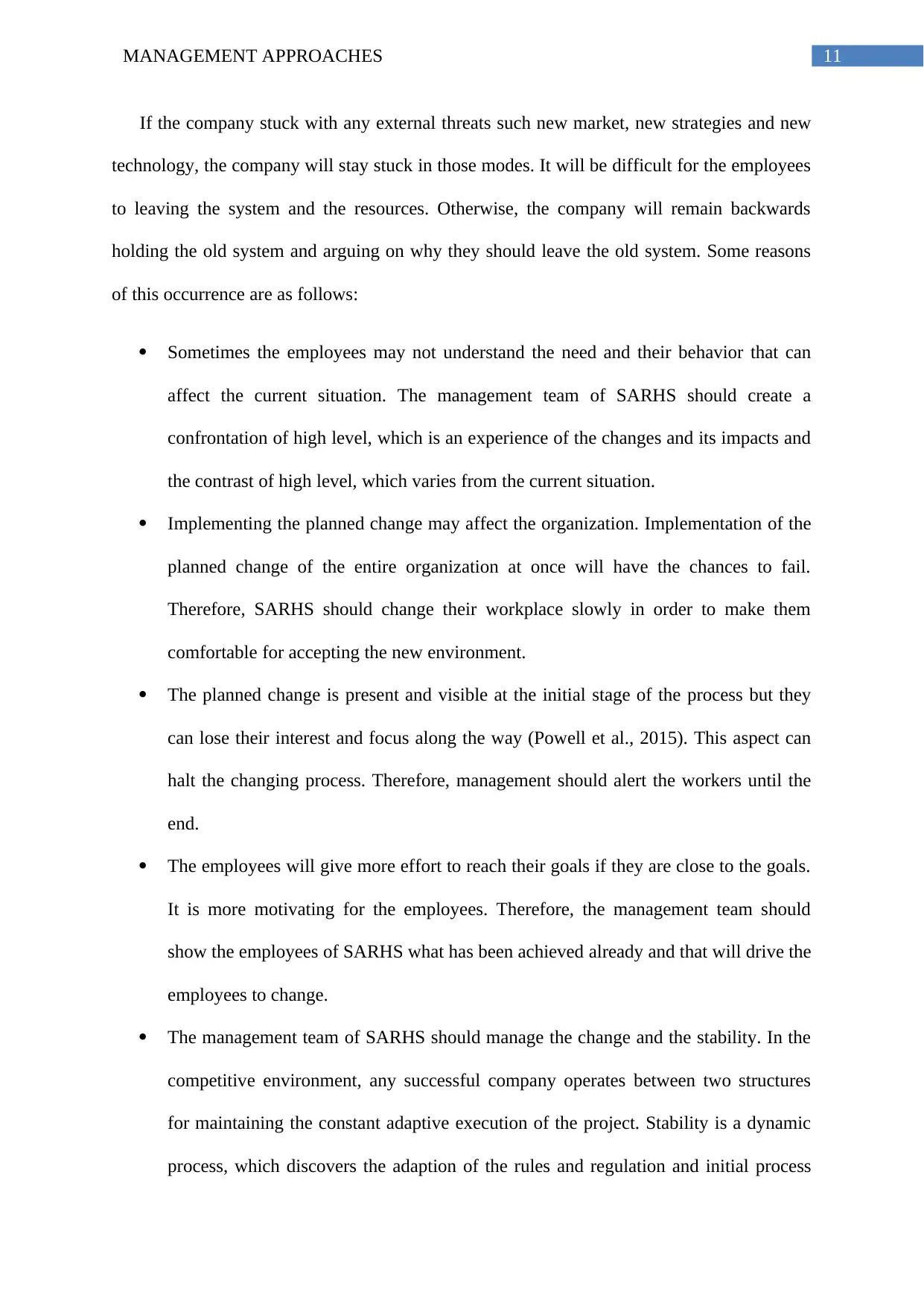
11MANAGEMENT APPROACHES
If the company stuck with any external threats such new market, new strategies and new
technology, the company will stay stuck in those modes. It will be difficult for the employees
to leaving the system and the resources. Otherwise, the company will remain backwards
holding the old system and arguing on why they should leave the old system. Some reasons
of this occurrence are as follows:
Sometimes the employees may not understand the need and their behavior that can
affect the current situation. The management team of SARHS should create a
confrontation of high level, which is an experience of the changes and its impacts and
the contrast of high level, which varies from the current situation.
Implementing the planned change may affect the organization. Implementation of the
planned change of the entire organization at once will have the chances to fail.
Therefore, SARHS should change their workplace slowly in order to make them
comfortable for accepting the new environment.
The planned change is present and visible at the initial stage of the process but they
can lose their interest and focus along the way (Powell et al., 2015). This aspect can
halt the changing process. Therefore, management should alert the workers until the
end.
The employees will give more effort to reach their goals if they are close to the goals.
It is more motivating for the employees. Therefore, the management team should
show the employees of SARHS what has been achieved already and that will drive the
employees to change.
The management team of SARHS should manage the change and the stability. In the
competitive environment, any successful company operates between two structures
for maintaining the constant adaptive execution of the project. Stability is a dynamic
process, which discovers the adaption of the rules and regulation and initial process
If the company stuck with any external threats such new market, new strategies and new
technology, the company will stay stuck in those modes. It will be difficult for the employees
to leaving the system and the resources. Otherwise, the company will remain backwards
holding the old system and arguing on why they should leave the old system. Some reasons
of this occurrence are as follows:
Sometimes the employees may not understand the need and their behavior that can
affect the current situation. The management team of SARHS should create a
confrontation of high level, which is an experience of the changes and its impacts and
the contrast of high level, which varies from the current situation.
Implementing the planned change may affect the organization. Implementation of the
planned change of the entire organization at once will have the chances to fail.
Therefore, SARHS should change their workplace slowly in order to make them
comfortable for accepting the new environment.
The planned change is present and visible at the initial stage of the process but they
can lose their interest and focus along the way (Powell et al., 2015). This aspect can
halt the changing process. Therefore, management should alert the workers until the
end.
The employees will give more effort to reach their goals if they are close to the goals.
It is more motivating for the employees. Therefore, the management team should
show the employees of SARHS what has been achieved already and that will drive the
employees to change.
The management team of SARHS should manage the change and the stability. In the
competitive environment, any successful company operates between two structures
for maintaining the constant adaptive execution of the project. Stability is a dynamic
process, which discovers the adaption of the rules and regulation and initial process
⊘ This is a preview!⊘
Do you want full access?
Subscribe today to unlock all pages.

Trusted by 1+ million students worldwide
1 out of 19
Related Documents
Your All-in-One AI-Powered Toolkit for Academic Success.
+13062052269
info@desklib.com
Available 24*7 on WhatsApp / Email
![[object Object]](/_next/static/media/star-bottom.7253800d.svg)
Unlock your academic potential
Copyright © 2020–2025 A2Z Services. All Rights Reserved. Developed and managed by ZUCOL.





